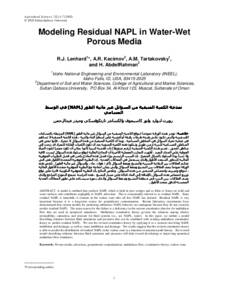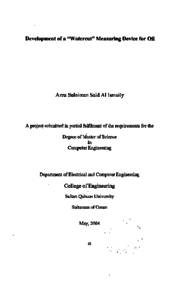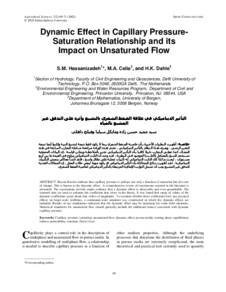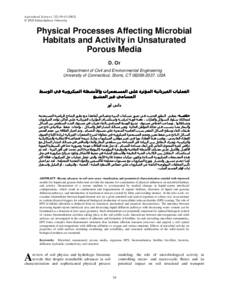Document
Modeling residual NAPL in water-wet porous media.
Contributors
Publisher
Sultan Qaboos university
Gregorian
2002
Language
English
Subject
English abstract
A model is outlined that predicts NAPL which is held in pore wedges and as films or lenses on solid and water surfaces and contributes negligibly to NAPL advection. This is conceptually referred to as residual NAPL. Since residual NAPL is immobile, it remains in the vadose zone after all free NAPL has drained. Residual NAPL is very important because it is a long-term source for groundwater contamination. Recent laboratory experiments have demonstrated that current models for predicting subsurface NAPL behavior are inadequate because they do not correctly predict residual NAPL. The main reason for the failure is a deficiency in the current constitutive theories for multiphase flow that are used in numerical simulators. Multiphase constitutive theory governs the relations among relative permeability, saturation, and pressure for fluid systems (i.e., air, NAPL, water). In this paper, we outline a model describing relations between fluid saturations and pressures that can be combined with existing multiphase constitutive theory to predict residual NAPL. We test the revised constitutive theory by applying it to a scenario involving NAPL imbibition and drainage, as well as water imbibition and drainage. The results suggest that the revised constitutive theory is able to predict the distribution of residual NAPL in the vadose zone as a function of saturation-path history. The revised model describing relations between fluid saturation and pressures will help toward developing or improving numerical multiphase flow simulators.
Member of
ISSN
2410-1079
Resource URL
Citation
Lenhard, R. J., Kacimov, A. R., Tartakovsky, A. M., & Abdel Rahman, H. (2002). Modeling residual NAPL in water-wet porous media. Journal of Agricultural and Marian Sciences, 7 (2), 1-7.
Arabic abstract
توجز هذه الورقة نموذجا لتوقع الكمية المتبقية من السوائل غير مائية الطور ( NAPL ) المرتبطة بالمسامات الإسفينية والتي تكون على هيئة طبقات رقيقة أو أغشية على أسطح الماء والتربة، هذه الكمية المتبقية لا تساهم في عملية تحرك السوائل في المناطق المسامية. وبما أن الكمية المتبقية من هذه السوائل لا تتحرك، فإنها تبقى في المناطق المسامية للتربة لزمن طويل وتتكون هذه الكمية المتبقية بعد أن تكون الكميات القابلة للتحرك قد نزحت إلى مناطق أعمق. تعتبر هذه الكمية المتبقية (رغم صغرها) ذات أهمية كبيرة لأنها يمكن أن تكون مصدرا لتلوث المياه الجوفية على المدى البعيد. أظهرت التجارب المعملية الأخيرة أن النماذج الحالية لتوقع سلوك هذه السوائل ليست كافية ولا تتنبأ بهذا السلوك بالشكل الصحيح. إن السبب الرئيسي وراء فشل هذه النماذج يكمن في فشل النظريات الجوهرية الحالية للتدفق المتعدد الأطوار والذي يستعمل في المحاكات العددية. إن النظرية الجوهرية المتعددة الأطوار هي التي تحكم العلاقات بين النفاذية النسبية والتشبع وضغط السوائل (أي ؛ هواء، ماء، والسوائل غير مائية الطور). تلخص هذه الورقة نموذجا يصف العلاقات بين التشبع وضغط السوائل والتي يمكن إدماجه مع النظرية الجوهرية متعددة الأطوار الحالية، لتوقع وتصريف وادمصاص المتبقي من هذه السوائل. وتلخص النتائج بأن النظرية الجوهرية التكوينية قادرة على توقع توزيع ادمصاص هذه السوائل بالإضافة إلى الماء كدالة على مسار التشبع. هذه الدراسة تشجع النموذج المراجع والذي يصف العلاقات بين الترب في منطقة التشيع وضغط السوائل والذي بدوره سيساعد على تطوير المحاكات العددية المحسنة للدفق متعدد الأطوار .
Category
Journal articles




